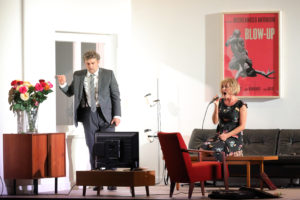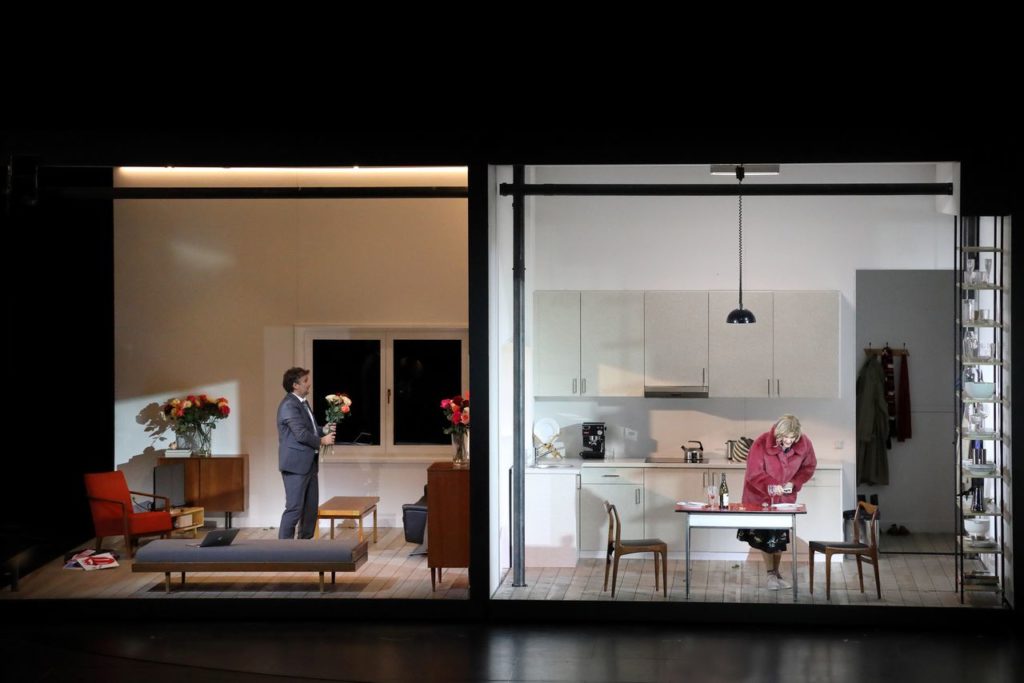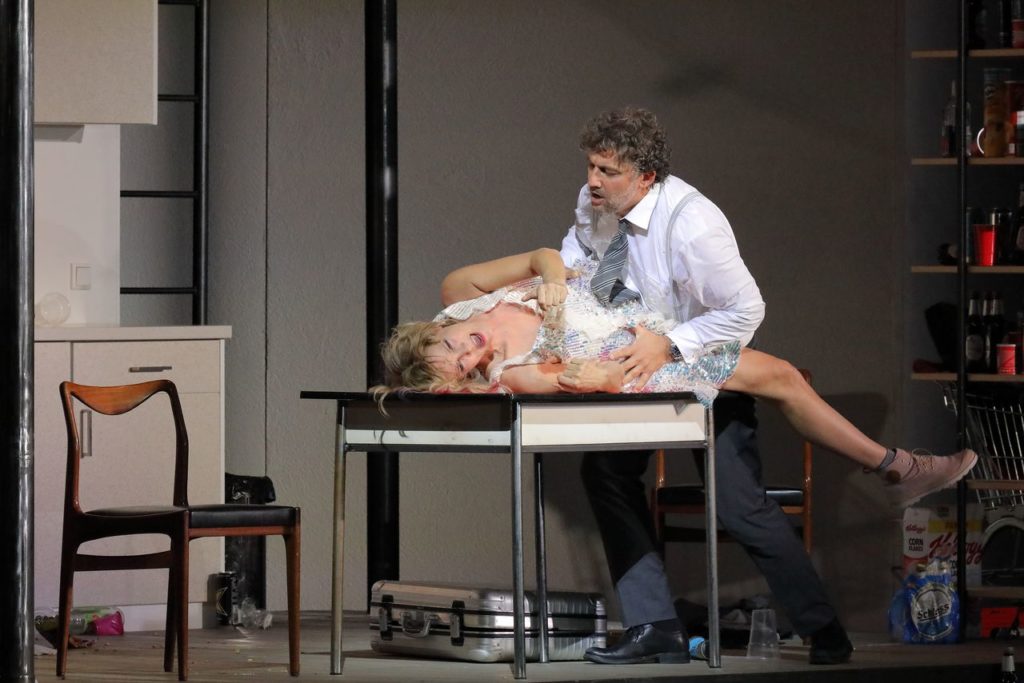
Bayerische Staatsoper 2019–20 Review: Die tote Stadt
Star Soprano Marlis Petersen Shines As The Girl of Jonas Kaufmann’s Dreams
By Polina Lyapustina(Credits: W. Hoesl)
“A single dream is more powerful than a thousand realities.”
J.R.R. Tolkien
We all dream. About a better world, a better life, pure happiness. But a man who has suffered the loss cannot be carefree anymore, even in the illusional life. Forced to live in a world where his sweetest dreams always turn into his worst nightmares, he will confront his own perception of happiness at some point.
The young man trying to overcome the loss of his beloved wife then meets a woman who looks and (he believes) behaves like his spouse. He falls in love instantly. It doesn’t work as he planned and in a short time, he makes sure of a huge gap between “the saints and whores.” Disappointed and broken, he kills his new lover. He then awakens to reality.
How much must one hate reality to dream this way?
Musical Juxtapositions
Austrian composer Erich Wolfgang Korngold was just 23 when he adapted the play into the libretto (together with his father) and composed “Die tote Stadt.” Perhaps, the thoughts about inner confrontation of one’s own dreams may seem too serious for such a young musician, but child-prodigy had paved his way to this serious topic for over a decade.
The result is quite mature.
How would you imagine the sound of the dead city? Whispers, wheeze, howls? According to Korngold, it sounds like a good old movie soundtrack, something we used to hear many times before, but also something the composer couldn’t experience at the beginning of the 20th century — these movies as well as such music didn’t exist at that time. Later Korngold was one of the founders of Hollywood film music along with Max Steiner and Alfred Newman.
The music of “Die tote Stadt” is diverse. We hear a waltz, a lovely heritage of previous centuries. We hear dance music to keep the world alive, but it’s so distant, that neither the characters nor the audience belongs to it. We hear thrilling chords in the background of a sweet romantic song. It’s all melting into one framework. What’s this? The dream? The nightmare? The reality?
Marches, lieder, and operetta are melted in. You wish it would sound that light and careless as it seems, but there’s also a dramatic line either behind or in front of it.
The two main lines (of Paul and Marietta) are both ambivalent. No matter how happy and reckless Marietta is, you always hear heavy orchestra chords. Paul is the opposite — filled with grief and telling his stories of struggle (which are even more dramatic in the voice of Jonas Kaufmann), the main character always has a light shade of hope in the orchestral accompaniment.
There are a lot of things being said about Strauss, Wagner, and Berg in this music. And yet, the interpretation of Kirill Petrenko allowed the listener to engage with the very core of all these mixes and borrowing — where the pure soul of the composition lay. The conductor’s interpretation was fresh and vivid. No matter how far the madness and the fantasy went, you could trust the feeling of music and take every particular moment as reality, becoming truth even for just a second.
The composition is truly tangible and multilayered, but also it’s effectively scaled into something you can overview at once. You twist it in your hands, peering and listening to small convincing details that form a picture of hope or madness in the real world.

(Credits: W. Hoesl)
Play
Director Simon Stone has his own respectful perception of this story. He calls it difficult, even hard to tell, but truly beautiful. And you cannot argue with it. In his production, which was as multilayered as the music, the world is also scaled — into the form of a house, a kind of Rubik’s cube, that is rebuilt according to Paul’s madness.
When the music calls us to concentrate on some feeling — Stone finds a perfect place in the apartment to reflect it. When madness drives Paul to a dangerous state, the director sends us upstairs — to experience vertigo and swirls of jealousy and anger with the character.
This production serves to both the idea and the music. It never deprives us of listening and of thinking. If it sends the tenor inside a box, his sound only benefits from it, becoming more convincing. When soprano needs to shine out in all the splendor of her attraction and a beautiful dress, her voice can fill the hall with no barriers — the staging builds a right angle to conduct the sound.
But the main advantage of this production is not a staging solution, but the director’s perspective of the inner war of the main hero. The man who’s dreaming of being betrayed doesn’t wish to be happy as he was. He needs to heal his wounds and break free. Torturing himself with an idea of no happy-ending with Marie or Marietta, he finally gets to the point where he truly believes that his life, as well as the whole world around him, is dead as long as he feeds it with dreams of the dead.
How well does Paul seem to us, losing his mind to suffer in his delusion? How strong and brave is this decision to be healed by pain? It’s not madness, Simon Stone insists, it’s rehabilitation.
Tortured Soul & His Dream Girl
Jonas Kaufmann doesn’t perform a lot of operas throughout the year and a role debut is definitely an extraordinary case. There is a lot of chatter on the state of his voice given his cutback on performances and numerous cancelations.
Fortunately, that night the singer was at his very best. He easily produced clear high notes (which were quite rare in his interpretation) and a highly agile and robust sounding lower range.
The tenor took great advantage of his lower voice, giving Paul a vocal and emotional arc that explored a path from the deepest grief to hope and acceptance throughout the evening.
Kaufmann showcased the total control of his voice and the ability to interpret the young role. His signature pianissimo came in handy to soften the tenor’s heroic tone and exacerbate Paul’s mental condition.
Paul’s vocal line is probably the most complex but solid at the same time. It mixes numerous small details — lovesongs, dances, horror movie cues. But in the end, it all leads to a logical and harmonic aria, so you can believe that this man has hope of healing.
Kaufmann was challenged with showcasing this breadth of vocal color while also exploring the fact that time and space are compressed in this story, its narrative taking place within his head in a short span of time. In this context, the man could never change noticeably. Kaufmann managed the feat admirably.
Meanwhile, soprano Marlis Petersen continued her triumphant season at the Bayerische Staatsoper. After her expressive Salome, she proved yet again that her strong, agile, and bright voice is the best instrument for any 20th-century opera.
Ambivalence seems to be her calling card. Romantic songs filled with hope are mixed with disappointment. The thrills of passion are combined with the anxiety of boredom. The soprano herself called this role “both saint and whore,” but, ultimately, she managed to remain whole.
The key is that we don’t know her. The real Marietta is hidden from us, and all we can see is a sick illusion in Paul’s head. That’s why her lines are so straight, her notes are clean and easily predictable (the dream girl would definitely sing like that) in the perfect world. But think about how difficult it is to perform them in this manner on the real stage.
Marlis Petersen felt comfortable and confident in the company of Petrenko and Kaufmann, and to be honest, stole the stage that night. Her performance exuded youth, freshness, and pristine vocal and technical sophistication. A dream soprano, indeed.

Credits: W. Hoesl
The Agents of Real & Madness
Besides the terrific leading cast, the performance was full of great supporting singers. Frank (as well as Fritz) was interpreted by Andrzej Filonczyk, who brought a heart-warming performance full of passionate acting. His baritone is powerful and very agile, which allows him to sing in the wide range and deal with high notes in legatos effortlessly. His two roles of a real friend and imaginary rival are very different, but both convincing and very direct.
Mirjam Mesak, Corinna Scheurle, Manuel Günther, and Dean Power made an excellent supporting team for Marietta’s high point, personifying her cheerful lifestyle as unacceptable for Paul. Their singing had noticeable qualities, and their acting and choreography were on a similar level.
And yet, every character of these had a single quality and mood throughout the performance. In the life of the dead city and Paul’s delusion, they play roles of scenery, reflecting or adding a background and some new values to the actions and decisions of the protagonist.
The biblical cleansing through suffering, self-confrontation, and pure grief make this opera special for the modern world. A world, where we believe that “feeling good” is the best treatment and where our cupboards are overfilled with skeletons behind the beautifully armored doors.
Paul seems crazy and his delusions are just a sign of mental illness for us. But in Stone’s brilliant interpretation, it’s, fortunately, not that simple. Rebuilding the set, he also turns the subconscious of the character inside out — and what we see is his autopsied soul, still alive, still fighting for life. And even winning this fight.
When our generation of “feeling good” survives the age of stress, a young composer from the beginning of the 20th century calls us to war. To the fight that lies behind those beautiful facades we wear.
In the powerful pianissimo of Jonas Kaufmann, he urges us to hear our inner voice. In the bright hight notes of Marlis Petersen, he asks about what is real. In the vivid interpretation of Kirill Petrenko, he shows the world which is always bigger than the one we can see, even if it’s scaled into a Rubic’s cube or a wretched Dead city.




